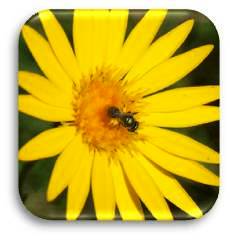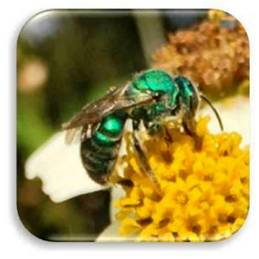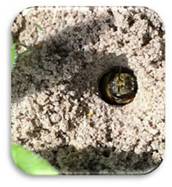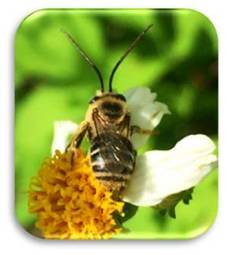Small Bees (1/3″ “pea-size”) and Tiny Bees (1/4″ “grain of rice”)
Texas Parks & Wildlife (TPWD) Species of Greatest Conservation Need
- Perdita atriventris
- p.dolanensis
- p.fracticincta
- p.tricincta
Sweat Bees

Sweat Bees
Lasioglossum
Size: 1/4″ or less
Season: Mar – Sept.
Description: Small sweat bees are found throughout the world on every continent except Antarctica. Very small and ranging in color from all black to gray and brown. Females carry pollen on scopa (long hairs) on her hind legs. Often mistaken for gnats or flies.
Lasioglossum are the most abundant bees in gardens, but are often overlooked due to their small size.

Metallic Green Sweat Bee
Augochlorella; Agapostemon splendens; Agapostemon texanus
Size: 1/3″
Season: Mar – Nov in Houston. In the northern United States, first sightings of female Agapostemon occur mid to late May.
Description: Known for their striking metallic ‘race car green’ color, Metallic Green Sweat Bees are in the Western Hemisphere from central North America south to Central America and parts of South America. They are Houston natives and one of the most common visitors to backyard gardens. Most females are completely green, while males have yellow and black stripes on the abdomen.
Sweat bees are effective pollinators, generalists that forage on a wide variety of flowers from early summer through fall. With a relatively long tongue, they can access complex or slightly closed flowers.

Pictured is a female sweat bee peeking from her nest in the ground. Sweat bees nest in the ground (as do 70% of bees). Habitats include woodlands, gardens, meadows, prairies, old fields, farms and urban, suburban and rural areas. Since they can’t nest in mulch-covered ground, avoid mulch and pesticides in your garden.
Longhorn Bee
Texas Parks & Wildlife (TPWD) Species of Greatest Conservation Need
- Longhorn Bee (Eucera birkmanniella)

Longhorn Bee
Eucera; Mellisodes
Size: 1/3″ “Pea”
Season: June – Sept.
Description: Longhorn Bees live throughout North America and in parts of Central and South America. They are effective pollinators of many open-flower forms, including sunflowers, and can be consistently found foraging on plants in the Asteraceae family. Males have noticeably long antennae, with pale brown hairs on thorax and banded abdomen. Females have scopa (pollen-collecting hairs) on its hind legs.
6 species call Harris County home. What a great Texas bee! Longhorn Bees for state bee!
Nesting: Ground-dwelling (preferring sand or clay soils).

